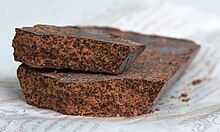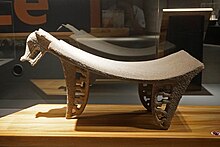
The cioccolato di Modica (Modica chocolate or chocolate of Modica, also known as cioccolata modicana) is an Italian protected geographical indication (PGI) specialty chocolate, typical of the comune (municipality) of Modica, in Sicily, characterized by an ancient and original recipe using manual grinding (rather than conching) which gives the chocolate a peculiar grainy texture and aromatic flavor. As prodotto agroalimentare tradizionale (PAT), it is a specialty officially recognized by the Italian Ministry of Agriculture, Food and Forestry Policies. Modica chocolate is made "cold" (a freddo) according to a traditional recipe and is not conched.


History and characteristics
The specialty was introduced in the County of Modica by the Spaniards, during their domination in southern Italy. Their noble house was the most influential feudal power in southern Italy in the 16th century, during the Spanish domination of Sicily. Even today there is a similar form of preparation in Spain in the form of chocolate a la piedra; such varieties are also known in Mexico and Guatemala. According to Leonardo Sciascia, the recipe comes from Alicante; there were originally only two forms of preparation, with cinnamon and with vanilla. Before the product became an internationally known specialty, it was a holiday dessert in noble families. The Spaniards probably learned from the Aztecs the technique of processing cocoa beans through the use of metate; however, Modica chocolate uses sugar in addition to cocoa, an ingredient which would have been unavailable to the Aztecs.
Modica chocolate only became nationally known in 1999, when the chocolatier Franco Ruta published a newspaper article and subsequently appeared on the Maurizio Costanzo Show on television. Ruta was managing director of Antica Dolceria Bonajuto, founded in 1880 and called Caffè Roma until 1992. It has been in the hands of Franco Ruta's son Pierpaolo Ruta since 2016. At the same time as Ruta's television appearance, the popular police series Inspector Montalbano, which was partly filmed in Modica, was broadcast on Italian television. The comune (municipality) of Modica reinforced this publicity by hosting an annual chocolate fair ("Chocobarocco"). Within a short period of time there were 75 companies in Modica producing or selling chocolate. The chocolate industry thus became the city's largest employer.
In 2003, 20 local producers founded the Consorzio di Tutela del Cioccolato di Modica to protect Cioccolato di Modica as a protected geographical indication (PGI).
In 2017, the consortium also applied for protection at EU level as protected geographical indication for the same designation, which was granted in October 2018 with the Implementing Regulation (EU) 2018/1529.
The Antica Dolceria Bonajuto, which is considered to be the oldest still existing chocolate shop in the region, did not participate in the consortium. Rather, the Ruta family criticized the specification as insufficient and, after the publication of the PGI, produced chocolates as a provocation under the name cioccolato di un paese vicino a Ragusa (lit. 'chocolate from a village near Ragusa').
Manufacturing
Modica chocolate is cold processed and has no cocoa butter added, at 45 degrees Celsius and without the conching process sugar does not dissolve; that's why it has a different texture. The finished chocolate therefore has a grainy, rough consistency, with the inclusion of small air bubbles; it crumbles when broken. When sold, the bars are slightly gray on the surface due to the cocoa butter that has been excreted. In the mouth, the chocolate unfolds an intense cocoa aroma. According to the age old Modica cold working process all the beneficial properties of cocoa are kept intact.
Ground cocoa, from which the cocoa butter has not been extracted, is heated to a maximum of 40 °C (104 °F). Sugar is added to the mass and possibly a spice such as cinnamon, vanilla, ginger, chili, ground almonds or nuts or grated citrus peel. The cocoa content is 45–90%. In traditional hand preparation, the mass was rolled out in a crescent-shaped, heated mold made of lava rock in several steps with rollers of different thicknesses until it had the desired consistency. Nowadays this is done by machines. The finished, warm chocolate mass is then poured into pewter molds in the form of thick bars.
Modica chocolate often has a white patina and tends to crumble. The cocoa butter blooming alters the traditional organoleptic properties of the product. Apart from the substances mentioned, Modica chocolate contains no other ingredients, in particular no milk, no butter, no vegetable fat and no lecithin.
Events
From 2005 to 2008, Modica hosted Eurochocolate alongside Perugia. Since 2009 a festival named "Chocobarocco" is held every year in the city, organized together with the Fine Chocolate Organization.
See also
References
- "Mipaaf - Tredicesima revisione dell'elenco dei prodotti agroalimentari tradizionali". politicheagricole.it. Retrieved 9 December 2014.
- "Modican chocolate: Sicily's Ancient Bar of Cocoa - Great Italian Chefs".
- Laura Mantovano (2004). I maestri del cioccolato. Gambero Rosso, 2004. ISBN 8887180806.
- Elsa Mazzolini, Alessandra Meldolesi (2004). L'Italia del cioccolato. Touring Editore, 2004. ISBN 8836532926.
- Anthony Di Renzo (August 2010). Bitter Greens. SUNY Press, 2010. ISBN 978-1438433196.
- Joanne Lane (5 February 2011). Siracusa & Sicily's Southeast. Hunter Publishing, Inc, 2011. ISBN 978-1556502026.
- Dolceamaro : storia e storie dal cacao al cioccolato. Zeffiro Ciuffoletti. Firenze: Alinari. 2003. p. 87. ISBN 88-7292-462-6. OCLC 930422261.
{{cite book}}: CS1 maint: others (link) - Sciascia, Leonardo (1983). La contea di Modica. Giuseppe Leone. Milano: Electa. ISBN 88-435-0980-2. OCLC 18059270.
- "Cioccolato "bean to bar": dalla fava alla tavoletta. Moderne contaminazioni di Bonajuto". la Repubblica (in Italian). 2019-08-21. Retrieved 2023-04-25.
- "Una CIOCCOLATA con SCIASCIA - la Repubblica.it". Archivio - la Repubblica.it (in Italian). 28 February 2014. Retrieved 2023-04-25.
- ^ Ferrante, Stefano (2019-10-08). "Antica Dolceria Bonajuto non fa Cioccolato di Modica, ma possiamo spiegarvi". Dissapore (in Italian). Retrieved 2023-04-25.
- Entrepreneurship and cluster dynamics. Cristina Boari, Tom Elfring, Xavier F. Molina-Morales. New York, NY. 2016. p. 218. ISBN 978-1-317-30000-7. OCLC 951623931.
{{cite book}}: CS1 maint: location missing publisher (link) CS1 maint: others (link) - "Durchführungsverordnung (EU) 2018/1529 der Kommission". www.eur-lex.europa.eu. October 15, 2018. Retrieved April 24, 2023.
- Becchi, Michela (2015-10-18). "I grandi del cioccolato italiano. Bonajuto di Modica". Gambero Rosso (in Italian). Retrieved 2023-04-25.
- "Il cioccolato di Modica ottiene la certificazione Igp. Luci e ombre del disciplinare". Gambero Rosso (in Italian). 2018-10-16. Retrieved 2023-04-25.
- "Cioccolato di Modica, Igp e polemiche" (PDF). www.bonajuto.i. November 8, 2018. Retrieved April 25, 2023.
- "L'Eurochocolate a Modica". 2006-11-13. Archived from the original on 2006-11-13. Retrieved 2023-04-24.
- Isa Grassano (2011-10-04). 101 cose divertenti, insolite e curiose da fare gratis in Italia almeno una volta nella vita. Newton Compton Editori, 2011. ISBN 978-8854134188.
- Duncan Barry (November 5, 2011). "All things chocolate!". Times of Malta. Retrieved 21 March 2014.
- "Promossa dal Comune e da Fine Chocolate Organization "ChocoBarocco" a Modica dal 30 aprile al 3 maggio del 2009. – Radio RTM Modica" (in Italian). Retrieved 2023-04-25.
Further reading
- Emanuela Ferro (2009). Cioccolato di Modica. Un sapore antico nella cucina d'autore. Gribaudo, 2009. ISBN 978-8879068574.
External links
- Official website (in Italian)
- Riccardo Meggiato (April 26, 2012). "The Science Of Chocolate: How To Make Sicilian Chocolate". Fine Dining Lovers. Retrieved 21 March 2014.